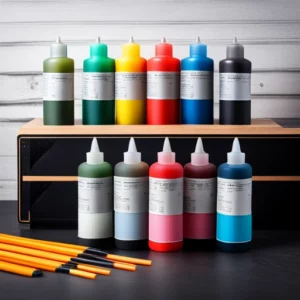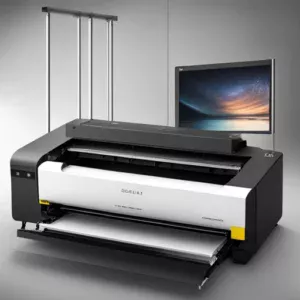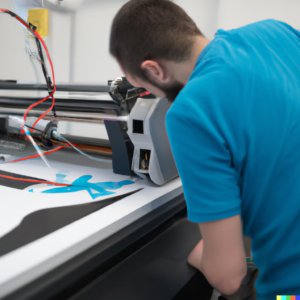What is Sublimation Printing?
Sublimation printing is a process of transferring images or designs to a variety of materials using heat and pressure. The image is first printed onto special sublimation paper, which is then placed on the desired material and heated. The heat causes the sublimation ink to vaporize and then re-solidify on the surface of the material, creating a permanent, high-quality print.

How Does Sublimation Printing Work?
Sublimation printing works by taking advantage of the unique properties of sublimation ink. Sublimation ink is a type of ink that changes from a solid to a gas when heated. When the sublimation ink is heated, it vaporizes and then re-solidifies on the surface of the material. The re-solidified ink bonds permanently to the material, creating a high-quality, long-lasting print.


What Materials Can Be Sublimated?
Sublimation printing can be used on a variety of materials, including:
- Polyester fabrics
- Ceramics
- Metal
- Glass
- Wood
- Acrylic
- Paper
What Are the Benefits of Sublimation Printing?
There are many benefits to sublimation printing, including:
- High-quality prints that are permanent and fade-resistant
- Wide range of materials that can be sublimated
- Relatively easy to learn and do
- Affordable
What Are the Disadvantages of Sublimation Printing?
Some of the disadvantages of sublimation printing include:
- Can be expensive to set up
- Requires special equipment, such as a sublimation printer and heat press
- Not all materials can be sublimated
- Can be difficult to get perfect results
How to Get Started with Sublimation Printing
If you are interested in getting started with sublimation printing, there are a few things you will need:
- A sublimation printer
- Sublimation ink
- Sublimation paper
- A heat press
- A variety of materials to sublimate
Once you have all of the necessary supplies, you can start sublimating by following these steps:
- Design your image or transfer.
- Print your image onto sublimation paper.
- Place the sublimation paper face down on the desired material.
- Heat press the material according to the manufacturer’s instructions.
- Peel off the sublimation paper to reveal your permanent print.
Tips for Choosing the Right Sublimation Printer
When choosing a sublimation printer, there are a few things you will need to consider, such as:
- The size of the prints you want to create
- The type of materials you want to sublimate
- The features you need, such as automatic double-sided printing
Tips for Choosing the Right Sublimation Ink
When choosing sublimation ink, there are a few things you will need to consider, such as:
- The type of materials you want to sublimate
- The colors you want to use
- The quality of the ink
Tips for Designing Sublimation Transfers
When designing sublimation transfers, there are a few things you will need to keep in mind, such as:
- The size of the transfer
- The resolution of the image
- The colors used
Tips for Heat Press Settings
The heat press settings will vary depending on the type of material you are sublimating. However, in general, you will need to set the heat press to a temperature of 350-400 degrees Fahrenheit and the pressure to medium-high.
FAQs
Here are some frequently asked questions about sublimation printing:
Can I sublimate on dark fabrics?
Yes, you can sublimate on dark fabrics. However, you will need to use a special type of sublimation ink that is designed for dark fabrics. This ink will contain a white base that will allow the image to show up on the dark fabric.
What are the best materials to sublimate on?
The best materials to sublimate on are those that are made of polyester. Polyester is a synthetic fabric that is made from petroleum. It is a good conductor of heat, which is essential for sublimation printing. Other materials that can be sublimated include ceramic, metal, glass, wood, acrylic, and paper.
What is the difference between sublimation printing and heat transfer printing?
Sublimation printing and heat transfer printing are two similar printing processes. However, there are some key differences between the two. Sublimation printing uses heat and pressure to transfer an image or design to a material, while heat transfer printing uses heat and pressure to transfer a pre-printed transfer sheet to a material.
What are the limitations of sublimation printing?
Sublimation printing has a few limitations. First, it cannot be used on all materials. Second, it can be difficult to get perfect results. Third, it can be expensive to set up.
How can I improve my sublimation prints?
There are a few things you can do to improve your sublimation prints. First, use high-quality sublimation ink and paper. Second, make sure your heat press is set to the correct temperature and pressure. Third, practice makes perfect! The more you sublimate, the better your prints will become.
Where can I learn more about sublimation printing?
There are many resources available to learn more about sublimation printing. You can find books, articles, and videos online. You can also take a sublimation printing class.
Powered By Brent-FirstColor Image Ltd
I hope this article has been informative and helpful. If you have any further questions, please feel free to contact me.

